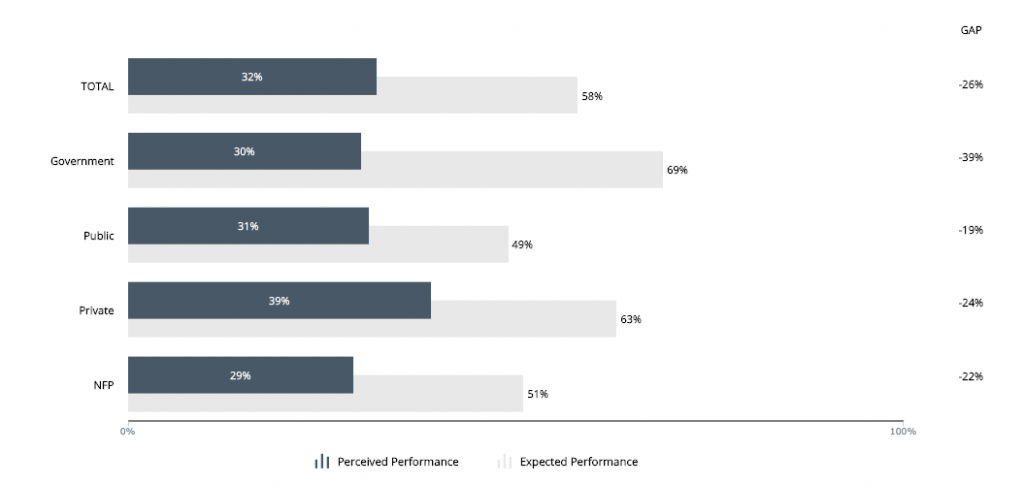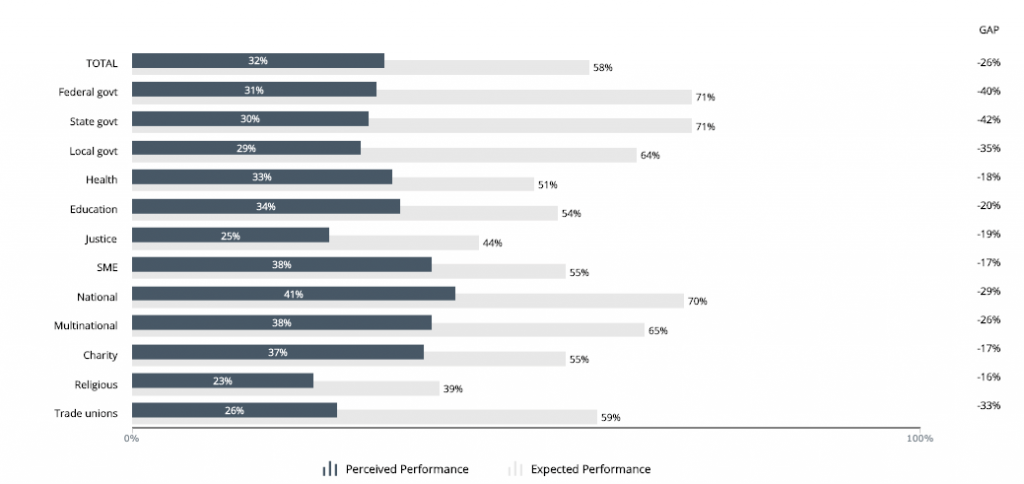Creating economic value through leadership
The Australian Leadership Index (ALI) is a national survey that provides a comprehensive picture of perceptions of leadership for the greater good in the government, public, private and not-for-profit sectors.
The ALI model of institutional leadership for the greater good delineates three sets of indicators of leadership for the greater good that pertain to the type of value that institutions seek to create, how institutions create value, and for whom institutions create value.
For each of these indicators, we measure public perceptions and expectations. In addition to this, we calculate the relationship between perceptions of each indicator and overall perceptions of leadership for the greater good, yielding insights into the key drivers of public perceptions of leadership in the government, public, private, and not-for-profit sectors.
This note is part of a three-part series on the type of value that institutions seek to create. The focus of this note, the second in the series, is on leaders’ focus on the creation of economic value, which the ALI defines as the creation of positive economic outcomes (e.g., fostering innovation and providing job opportunities).
A note on the survey process
The results reported in this research note are the average of the results obtained from quarterly ALI surveys (1,000 people per quarter) between September 2018 and March 2020, which represents seven quarters of data collection.
Respondents are recruited via an online panel by Dynata and recruitment is designed to ensure that the sample is nationally representative in terms of locality (i.e., States and Territories), gender and age.
Results are analysed at the overall national level, as well as at the sector (i.e., government, public, private and not-for-profit sectors) and institution-level. ALI results can be further segmented according to a range of demographic variables. More information about the survey process can be found here and the ALI data portal can be found here.
Economic value creation and leadership for the greater good
As community expectations have grown concerning the degree to which institutions, especially businesses, should create social value, there has been a concomitant decline in expectations that institutions should focus solely on creating economic value. In academe, there is a now voluminous literature on these topics, as found in research into corporate social responsibility and responsible leadership, to name but two strands of research in the domain of business and society.
What role do perceptions of leaders’ focus on creating economic value play in public perceptions of leadership for the greater good in the government, public, private and not-for-profit sectors?
Research by the Australian Leadership Index suggests that the answer depends to some degree on the sector under consideration.
ALI research reveals that public perceptions of leaders’ focus on creating social value is a weak predictor of leadership for the greater good in the government, public and not-for-profit sectors. Although concern about creating economic value in these sectors is not unimportant, it makes a very modest contribution to public perceptions of their leadership for the wider public interest.
Consistent with community expectations that business leaders should contribute to the well-being of society and not focus single-mindedly on the bottom line, ALI finds that perceptions of private sector leaders’ focus the creation of economic value is unrelated to public perceptions of their leadership for the greater good.
In sum, the degree to which leaders and their institutions are seen to care about and focus on creating positive economic outcomes has little-to-no relationship with perceptions of their leadership for the greater good.
Economic value creation at the sector-level
Having established the relationship between economic value creation and leadership for the greater good, it’s pertinent to consider what ALI reveals about public perceptions and expectations of economic value creation in the government, public and not-for-profit sectors.
The public have moderate expectations of the degree to which institutions in the public and not-for-profit sectors should be focused on creating economic value. Only half of respondents think public and not-for-profit sector institutions should focus on the creation of economic value to a “fairly large” or “extremely large” extent.
By contrast, the public have high expectations of the degree to which government and private sector institutions should focus on creating economic value. Roughly two-thirds of respondents think government and private sector institutions should focus on the creation of economic value to a “fairly large” or “extremely large” extent.
Unsurprisingly, the private sector is regarded as the strongest performer in terms of focus on economic value creation, with 39% of respondents judging the private sector to focus on the creation of economic value to “fairly large” or “extremely large” extent.
Again, unsurprisingly, the not-for-profit sector is seen the weakest performer on this criterion, with only 29% of respondents judging that not-for-profit institutions focus on the creation of economic value to “fairly large” or “extremely large” extent.
Similarly, the public sector is seen a weak performer on this criterion, with only 31% of respondents reporting that public sector institutions focus on creating economic value to “fairly large” or “extremely large” extent. However, the public also have the lowest expectations of this sector’s focus on economic value creation. Only 49% of respondents expect this sector to have a strong focus on economic value creation, yielding the smallest perception-expectation gap of the four sectors (18 percentage points).
The government sector has the biggest gap between perceptions and expectations (i.e., a 39 percentage point gap). Interestingly, of the four sectors examined, the government sector is associated with the highest public expectations of the extent to which they should focus on the creating economic value – 69% respondents expect this sector to focus on the creating economic value to “fairly large” or “extremely large” extent.

Figure 1. Perceived and expected focus on economic value creation, sector-level, Sept. 2018-March 2020
Explore this data for yourself via the ALI custom chart builder.
Economic value creation at the institution-level
Wide differences are found across institutions in both expectations and perceptions of economic value creation.
Large national businesses are regarded as the strongest performer in terms of focus on economic value creation, with 41% of respondents judging that national businesses focus on creating social value to “fairly large” or “extremely large” extent. Multinational corporations and small and medium-sized enteprieses are close behind.
Religious institutions are seen the weakest performer on this criterion, with 23% of respondents perceiving that religious institutions focus on the creation of economic value to “fairly large” or “extremely large” extent. Religious institutions are also associated with the smallest perception-expectation gap, yielding a 16 percentage point gap between perceptions and expectations. This is largely attributable to low public expectations of the extent to which they should focus on the creating positive economic outcomes – only 39% respondents expect religious institutions to focus on the creation of economic value to “fairly large” or “extremely large” extent.
State Governments are associated with the biggest gap between public perceptions and expectations, with a 42 percentage point gap between perceptions and expectations, followed closely by the Federal Government, with a 40 percentage point gap.

Figure 2. Perceived and expected focus on economic value creation, institution-level, Sept. 2018-March 2020
Explore this data for yourself via the ALI custom chart builder.




